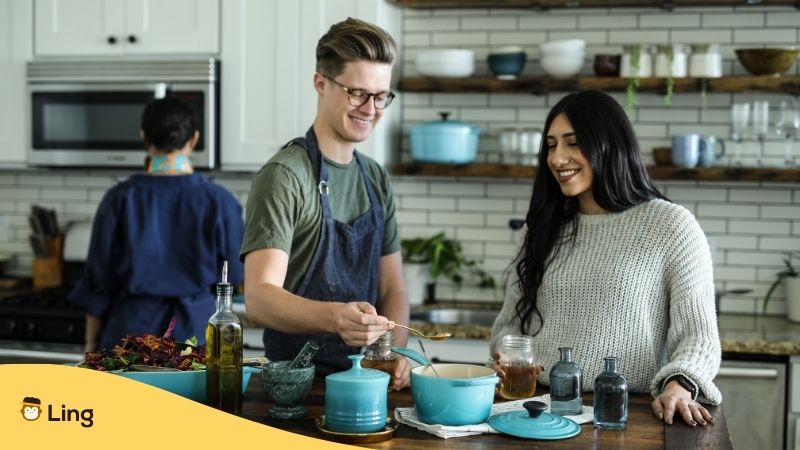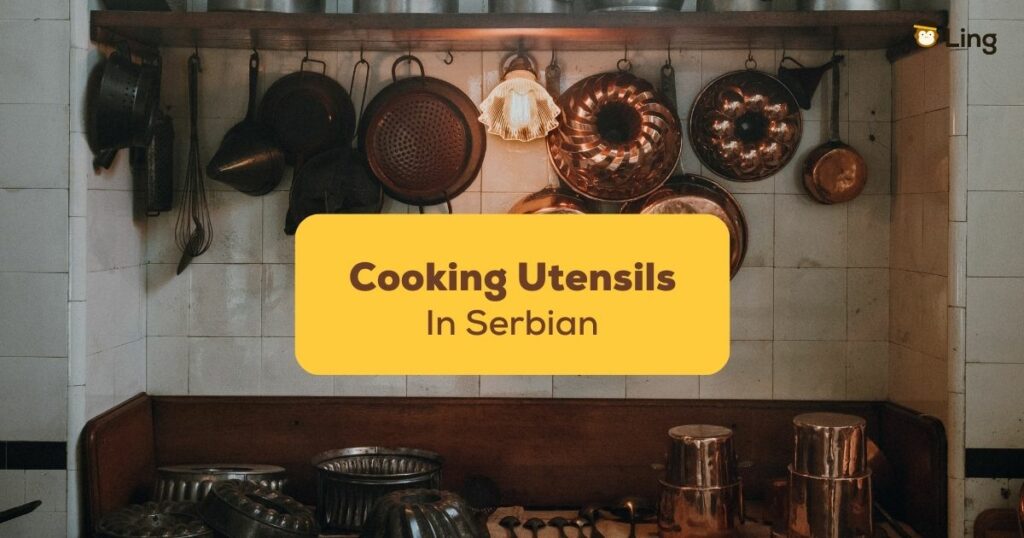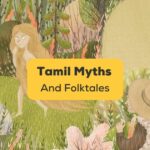Learning the names of kitchen utensils in Serbian is a terrific way to access the tools needed to cook up tasty Serbian cuisine. A country nestled in the heart of the Balkans, Serbia boasts an array of rich culinary heritage that reflects its history and diverse cultural influences. One thing I love about their food is most feature distinct cooking methods using a variety of traditional cooking utensils. In this blog post, we will delve into the world of Serbian cooking utensils, exploring their unique features and their role in shaping the country’s gastronomic traditions.
Cooking Utensils In Serbian
Sač
A large metal cooking pot with a wide bottom and handles on either side is an essential utensil in Balkan cuisine. It is commonly made of cast iron or copper and is used for slow-cooking stews, soups, and goulashes. The sač thick walls ensure even heat distribution, allowing the flavors to meld together over long hours of simmering, resulting in tender and flavorful dishes.
Đevđir
A traditional Serbian cooking pot made of clay. It is known for its ability to distribute heat evenly, which makes it perfect for slow-cooking Serbian food such as stews, soups, and other hearty dishes. The pot is usually round or oval in shape, with a lid that fits tightly to retain moisture and flavor.
Roštilj
Serbia is renowned for its love of grilled meats, and the roštilj plays a central role in this culinary tradition. This large, open-air grill typically consists of a rectangular metal frame with a charcoal or wood fire at the bottom.
The roštilj is used to prepare various types of meat, such as pljeskavica (Serbian burger made from minced meat and served on Pita bread or burger buns with toppings such as feta cheese, sour cream, and a Serbian salad), ćevapi (grilled sausages made from ground beef, and ground pork, finely chopped onions, garlic, paprika, salt and ground black pepper and usually served up with Pita bread or somun – Serbian flatbread), and ražnjići (skewered meats). It imparts a distinct smoky flavor to the dishes, making them incredibly delicious.
Čumur
A type of charcoal that is used in Serbian cooking to provide heat for grilling and roasting. It is made from hardwood, which gives it a distinctive flavor that is highly valued in Serbian cuisine and food preparation.
Šporet
A wood-fired stove that is commonly used in Serbian households for cooking a hearty meal. It is made of clay and has two compartments: one for burning wood and one for cooking. The stove is designed to retain heat, which makes it perfect for baking bread, roasting meat, and other slow-cooking dishes.
Pečenjara
A pečenjara is a long metal rod used for roasting whole animals, such as lamb, pork, or veal. It is a Serbian family tradition and a common sight during festive occasions and celebrations in Serbia, where spit-roasted meat takes center stage. The meat is slowly rotated over an open fire, allowing the juices to infuse the meat, resulting in tender and succulent flavors. The pečenjara requires skill and patience to achieve the perfect roast.

Šejtan
The šejtan, also known as a cooking bell or cloche, is a domed-shaped metal lid used for baking bread and other oven-baked dishes. It is placed over the food, trapping the steam and creating a mini-oven environment. This method ensures a moist and evenly cooked result. Serbian households often use the šejtan to prepare traditional bread varieties like lepinja and pogaca, as well as various casseroles and baked goods.
Tava
The tava is a flat, round frying pan used for cooking a wide range of Serbian meals, including traditional Serbian dishes like pljeskavica, punjena paprika (stuffed red bell peppers), and sarma (fresh cabbage rolls stuffed with ground beef and rice and served with sour cream and olive oil). Made of metal, such as cast iron or steel, the tava allows for quick and even cooking of meats and vegetables, giving them a delectable sear and enhancing their flavors.
Kajganara
A traditional Serbian skillet that is used for frying and cooking eggs. It is made of iron and has a slightly curved shape, making it perfect for flipping and stirring eggs. Kajganara is often used to make kajgana, a popular Serbian breakfast dish consisting of scrambled eggs with onions and peppers.
Rakijski Kazan
A traditional Serbian distillation pot used for making rakija – a popular Serbian brandy. The pot is usually made of copper and is designed to extract essential oils and flavors from fruits such as plums, apples, and grapes.
Varjača
A wooden spoon used in Serbian cooking for stirring and mixing ingredients. It is usually made of beech or other hardwoods and is designed to withstand high temperatures without melting or warping. Varjača is an essential tool in Serbian kitchens and is often passed down from generation to generation.
Serbian cooking utensils play an integral role in preserving the country’s culinary traditions. From the sac used for slow-cooked stews to the roštilj for grilling succulent meats, each utensil contributes to the unique flavors and textures found in Serbian food. Learning the names of these utensils not only provides insight into the cooking methods but also offers a glimpse into the cultural heritage of Serbia. So, whether you’re trying your hand at Serbian recipes or simply curious about the country’s gastronomy, understanding these kitchen utensils will enhance your culinary journey.

Other Cooking Utensils In Serbian
| English | Serbian | Transliteration |
| Refrigerator | Фрижидер | Frižider |
| Stove | Шпорет | Šporet |
| Oven | Рерна | Rerna |
| Microwave | Микроталасна | Mikrotalasna |
| Dishwasher | Машина за прање судова | Mašina za pranje sudova |
| Toaster | Тостер | Toster |
| Blender | Блендер | Blender |
| Coffee maker | Апарат за кафу | Aparat za kafu |
| Can opener | Отварач за конзерве | Otvarač za konzerve |
| Pot | Лонац | Lonac |
| Pan | Тава | Tava |
| Frying pan | Тигањ | Tiganj |
| Kettle | Кувало | Kuvalo |
| Measuring cups | Мензура | Menzura |
| Mixer | Миксер | Mikser |
| Cutting board | Даска за сечење | Daska za sečenje |
| Rolling pin | Оклагија | Oklagija |
| Baking dish | Ватросталну посуду | Vatrostalnu posudu |
Learn Serbian With Ling
Learning a new language like Serbian can seem impossible. But let me assure you it isn’t. Choosing the right teacher is half the battle, and the other half is having the determination to learn. With the Ling app, we have you covered! All of our lessons are written by native speakers who understand the pressures of picking up a foreign tongue. Plus, we made it possible for you to learn at your own pace and keep you interested in carrying on learning with a variety of entertaining teaching methods such as games and quizzes. Give Ling app a go today by clicking on App Store or Google Play.































